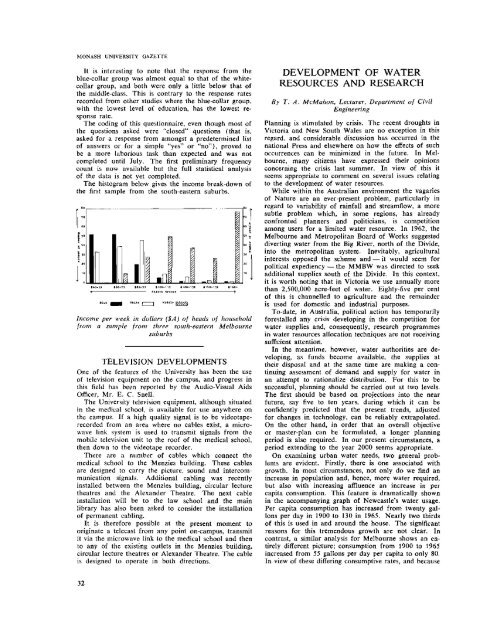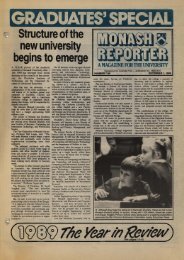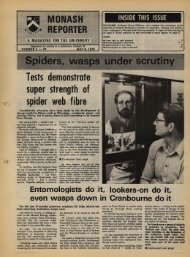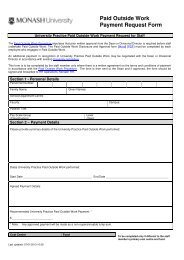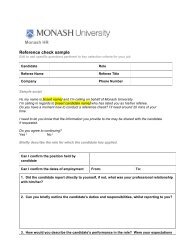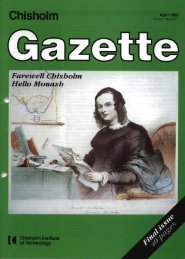GAZETTE - Adm.monash.edu.au - Monash University
GAZETTE - Adm.monash.edu.au - Monash University
GAZETTE - Adm.monash.edu.au - Monash University
- No tags were found...
You also want an ePaper? Increase the reach of your titles
YUMPU automatically turns print PDFs into web optimized ePapers that Google loves.
MONASH UNIVERSITY <strong>GAZETTE</strong>It is interesting to note that the response from theblue-collar group was almost equal to that of the whitecollargroup, and both were only a little below that ofthe middle-class. This is contrary to the response ratesrecorded from other studies where the blue-collar group.with the lowest level of <strong>edu</strong>cation, has the lowest responserate.The coding of this questionnaire, even though most ofthe questions asked were "closed" questions (that is,asked for a response from amongst a predetermined listof answers or for a simple "yes" or "no"), proved tobe a more laborious task than expected and was notcompleted until July. The first preliminary frequencycount is now available but the full statistical analysisof the data is not yet completed.The histogram below gives the income break-down ofthe first sample from the south-eastern suburbs.··~ I· •n, ,n.,.",.jIncome per week in dollars ($A) of heads of householdfrom a sample from three south-eastern MelbournesuburbsTELEVISION DEVELOPMENTSOne of the features of the <strong>University</strong> has been the useof television equipment on the campus, and progress inthis field has been reported by the Audio-Visual AidsOfficer, Mr. E. C. Snell.The <strong>University</strong> television equipment, although situatedin the medical school, is available for use anywhere onthe campus. If a high quality signal is to be videotaperecordedfrom an area where no cables exist, a microwavelink system is used to transmit signals from themobile television unit to the roof of the medical school,then down to the videotape recorder.There are a number of cables which connect themedical school to the Menzies building. These cablesare designed to carry the picture, sound and intercommunicationsignals. Additional cabling was recentlyinstalled between the Menzies building, circular lecturetheatres and the Alexander Theatre. The next cableinstallation will be to the law school and the mainlibrary has also been asked to consider the installationof permanent cabling.It is therefore possible at the present moment tooriginate a telecast from any point on-campus, transmitit via the microwave link to the medical school and thento any of the existing outlets in the Menzies building,circular lecture theatres or Alexander Theatre. The cableis designed to operate in both directions.DEVELOPMENT OF WATERRESOURCES AND RESEARCHBy T. A. McMahon, Lecturer, Department of CivilEngineeringPlanning is stimulated by crisis. The recent droughts inVictoria and New South Wales are no exception in thisregard, and considerable discussion has occurred in thenational Press and elsewhere on how the effects of suchoccurrences can be minimized in the future. In Melbourne,many citizens have expressed their opinionsconcerning the crisis last summer. In view of this itseems appropriate to comment on several issues relatingto the development of water resources.While within the Australian environment the vagariesof Nature are an ever-present problem, particularly inregard to variability of rainfall and streamflow, a moresubtle problem which, in some regions, has alreadyconfronted planners and politicians, is competitionamong users for a limited water resource. In 1962, theMelbourne and Metropolitan Board of Works suggesteddiverting water from the Big River, north of the Divide,into the metropolitan system. Inevitably, agriculturalinterests opposed the scheme and - it would seem forpolitical expediency - the MMBW was directed to seekadditional supplies south of the Divide. In this context•it is worth noting that in Victoria we me annually morethan 2,500,000 acre-feet of water. Eighty-five per centof this is channelled to agriculture and the remainderis used for domestic and industrial purposes.To-date, in Australia, political action has temporarilyforestalled any crisis developing in the competition forwater supplies and, consequently, research programmesin water resources allocation techniques are not receivingsufficient attention.In the meantime. however, water <strong>au</strong>thorities are developing,as funds become available, the supplies attheir disposal and at the same time are making a continuingassessment of demand and supply for water inan attempt to rationalize distribution. For this to besuccessful, planning should be carried out at two levels.The first should be based on projections into the nearfuture, say five to ten years, during which it can beconfidently predicted that the present trends, adjustedfor changes in technology, can be reliably extrapolated.On the other hand, in order that an overall objectiveor master-plan can be formulated, a longer planningperiod is also required. In our present circumstances, aperiod extending to the year 2000 seems appropriate.On examining urban water needs, two general problemsare evident. Firstly, there is one associated withgrowth. In most circumstances, not only do we find anincrease in population and, hence, more water required,but also with increasing affluence an increase in percapita consumption. This feature is dramatically shownin the accompanying graph of Newcastle's water usage.Per capita consumption has increased from twenty galIons per day in 1900 to 130 in 1965. Nearly two thirdsof this is used in and around the house. The significantreasons for this tremendous growth are not clear. Incontrast, a similar analysis for Melbourne shows an entirelydifferent picture; consumption from 1900 to 1965increased from 55 gallons per day per capita to only 80.In view of these differing consumptive rates, and bec<strong>au</strong>se32


